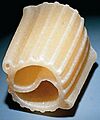List of pasta facts for kids
Pasta is a popular food made from dough, usually from wheat flour and water. It comes in many different shapes and sizes! You can find long pasta, short pasta, pasta filled with yummy ingredients, tiny pasta for soups, and even dumpling-like pasta.
Sometimes, the same pasta shape has different names depending on where you are in Italy. For example, a pasta shape called rotelle in some places is known as ruote in Italy. Pasta makers and chefs also love to invent new shapes, or they might give old shapes new names for fun.
Italian pasta names often end with special endings that tell you something about their size. For example, endings like -ini, -elli, or -ette usually mean "little." Endings like -oni mean "large." So, tortellini means "little tortelli," and cannelloni means "large reeds." All pasta names in Italian are plural, meaning they refer to more than one piece.
Contents
Long and Medium Pasta Shapes
Long pasta shapes are often made by pushing the dough through a special machine or by rolling it flat and then cutting it into ribbons.
- Spaghetti: This is one of the most famous long pasta shapes! It's thin and round, like little strings. Spaghettini is a thinner version, and spaghettoni is a thicker one.
- Linguine: These are like flattened spaghetti, shaped like little tongues.
- Fettuccine: These are flat, wide ribbons of pasta, a bit like thick noodles. They are great with creamy sauces.
- Tagliatelle: Similar to fettuccine, these are also flat ribbons, but usually a bit narrower. The name comes from the Italian word tagliare, meaning "to cut."
- Lasagna: These are wide, flat sheets of pasta. You often see them layered in baked dishes with sauce and cheese.
- Bucatini: This pasta looks like thick spaghetti, but it has a tiny hole running through the middle, like a hollow straw!
- Pappardelle: These are very wide, flat ribbons of egg pasta, perfect for rich, meaty sauces.
- Mafalde: These are long, rectangular ribbons with wavy, ruffled edges. They were named after Princess Mafalda of Savoy.
- Ziti: These are long, narrow tubes, often broken into smaller pieces before cooking. They are popular in baked dishes in Southern Italy.
Short Pasta Shapes
Short pasta shapes are also usually made by pushing the dough through a machine. They come in many fun and interesting forms!
- Penne: These are medium-length tubes with ridges, cut diagonally at both ends. They can be smooth (lisce) or grooved (rigate). The name means "pens" or "feathers."
- Rigatoni: These are large, ribbed tubes with straight-cut ends. Their ridges help hold onto sauces.
- Macaroni: These are small, curved tubes, often used in dishes like macaroni and cheese.
- Farfalle: These are shaped like bow ties or butterflies, and their name means "butterflies."
- Fusilli: These are corkscrew-shaped pasta, which can be solid or hollow. Their spirals are great for catching sauce.
- Conchiglie: These are shaped like seashells, and they are often grooved (rigate). Their hollow shape is perfect for holding sauce.
- Radiatori: These pasta shapes look like old-fashioned radiators, with lots of ridges and grooves that hold sauce well. They were invented between World War I and World War II.
- Cavatappi: These are corkscrew-shaped macaroni, also known as cellentani or spirali.
- Cascatelli: This is a newer pasta shape, designed in 2021. It's thick, half-tubed, and has ruffled sides, like "little waterfalls."
- Orecchiette: These are small, ear-shaped pasta from Southern Italy. They are often made by hand.
Stretched Pasta Shapes
Strascinati are pasta shapes that are often made by hand. They are "dragged" across a wooden board to create their unique forms.
- Orecchiette: As mentioned before, these are little ear-shaped pasta, a classic example of stretched pasta.
- Foglie d'ulivo: These are shaped like small olive leaves.
- Corzetti: These are flat, round pasta shapes that are stamped with decorative patterns, often from Liguria.
Soup Pasta Shapes
These are tiny pasta shapes, mostly used in soups. They are part of the pastina family, which means "small pasta."
- Acini di pepe: These are tiny, bead-like pasta, like "grains of pepper."
- Alphabet pasta: This pasta is cut into the shapes of letters, making soup fun!
- Orzo: This pasta is shaped like grains of rice or barley.
- Stelle: These are small, star-shaped pasta.
- Ditalini: These are short, small tubes, like "thimbles."
- Fregula: This is a bead-like pasta from Sardinia, often slightly toasted.
Filled Pasta Shapes
Filled pasta means pasta that has a delicious filling inside! The word raviolo (plural ravioli) can be used for almost any kind of filled pasta.
- Ravioli: These are usually square or circular pockets of pasta, filled with things like cheese, meat, or vegetables.
- Tortellini: These are small, ring-shaped pasta, often stuffed with meat and cheese. They are usually served in broth or with a light sauce.
- Tortelli: Similar to tortellini but larger, these can be square or half-moon shaped and have various fillings.
- Cannelloni: These are large rolls of pasta filled with ingredients, often baked in the oven with sauce.
- Mezzelune: These are semicircular pockets of pasta, meaning "half-moons."
- Fagottini: These are shaped like little "purses" or bundles, often filled with ricotta cheese and pear.
Gnocchi and Gnocchetti
Gnocchi are soft, dumpling-like pasta shapes, often made from potato or flour.
- Gnocchi: These are thick, soft dumplings, usually made from potato or semolina. They are often served with rich sauces.
- Canederli: These are small balls of dough, often made from bread crumbs, and are popular in soups.
Images for kids
See also
 In Spanish: Anexo:Pastas para niños
In Spanish: Anexo:Pastas para niños
- Italian cuisine
- List of Italian dishes
- Ragù – a meat-based sauce often served with pasta
- Semolina – a type of flour used to make pasta
- List of noodles












































































































































